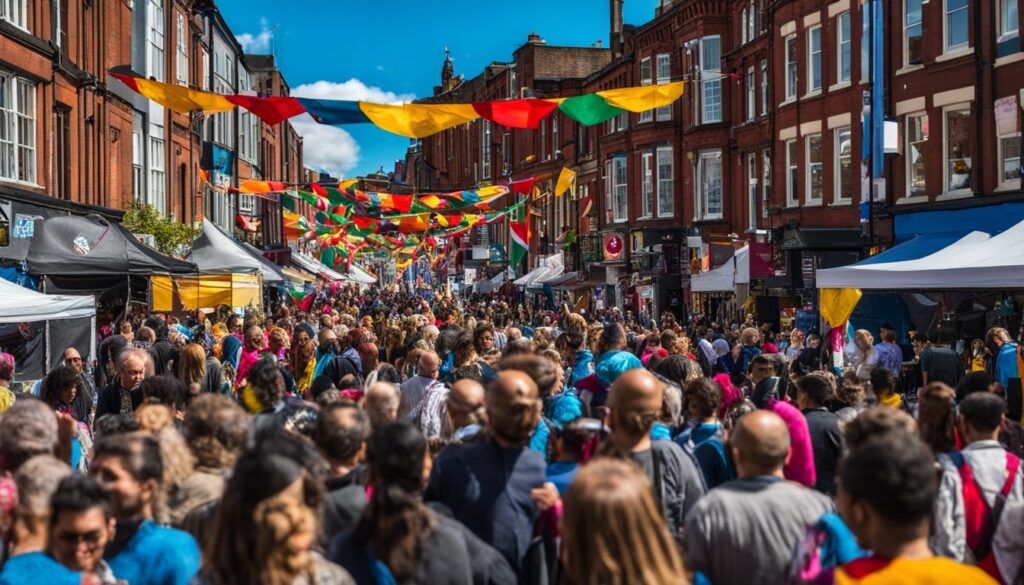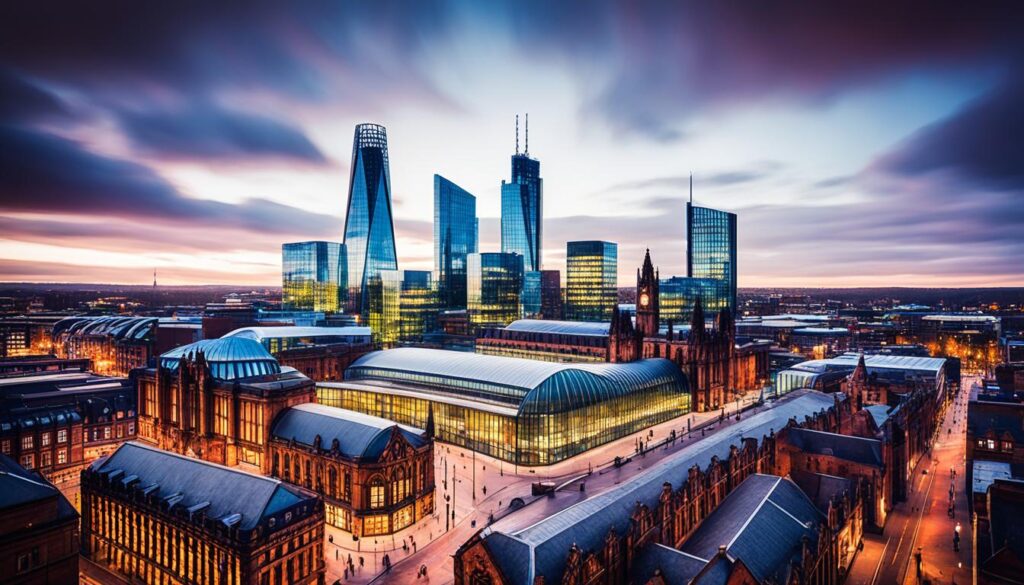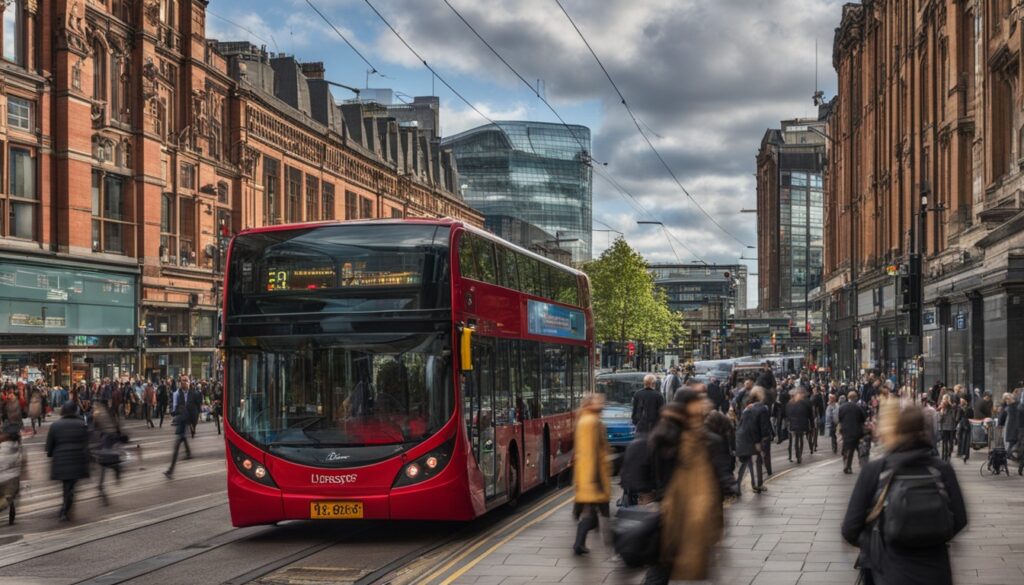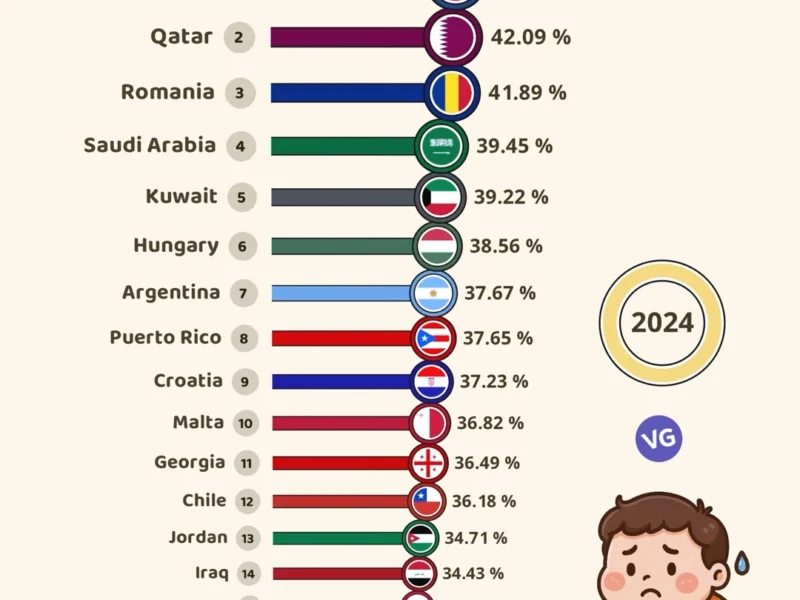Manchester is the UK’s second-largest urban area, full of life and diversity. Its population is growing fast. Is this growth due to a strong economy and high living standards, or does it face hidden problems?
The city’s population is racing ahead. By 2024, it’s expected to reach 2,811,756,1 up from 2,422,246 in 1950.1 This growth has made Greater Manchester one of the UK’s biggest metropolitan areas, with around 2.92 million people.1 Manchester itself is very crowded, with 12,210 people living in each square mile. This makes it the UK’s 9th most tightly packed city.1
The people in Manchester come from many different backgrounds. More than half are White, with 20.9% Asian and 11.9% Black.1 There are also many people of Mixed and other ethnicities. The city has 15.8% Muslims and more gay and lesbian people than average.1
Key Takeaways
- Manchester’s population is estimated to reach 2,811,756 by 2024, a significant increase from 2,422,246 in 1950.
- Greater Manchester is the second-largest urban area in the UK, with a population of around 2.92 million.
- Manchester is the 6th largest city in the UK, with a population density of 12,210 people per square mile, making it the 9th densest city.
- The city’s diverse population includes a large proportion of ethnic minority groups, with 20.9% identifying as Asian and 11.9% as Black.
- Manchester has a sizable Muslim population, accounting for 15.8% of the total, and a higher percentage of gay and lesbian individuals compared to the national average.
Exploring Manchester’s Rich History
Manchester’s story starts in the 1st century AD with a Roman fort, Mamucium, for safety.2 People have lived there ever since. You can see where they settled long ago at places like the Manchester Cathedral and Chetham’s Library.
From Roman Settlement to Industrial Powerhouse
In the Middle Ages, Manchester was just a small town. But, it quickly grew and changed when the 19th century came.2 This was because of the booming textile industry in the Industrial Revolution. Manchester led the way as the first city to become industrial. Soon, it was known as “Cottonopolis”.
The Legacy of the Industrial Revolution
Today, Manchester still shows signs of its industrial past with unique buildings and strong business spirits.23
manchester population: A Diverse and Growing Metropolis
Population Size and Growth Trends
Manchester’s population has been on the rise, hitting around 2,811,756 in 2024. This is a big jump from 1950 when it was only 2,422,246. Over the last 70 years, it’s grown by about 20%, with the early 2000s seeing a quick 19% spike.1 Many things are boosting this growth, like better jobs, more students from abroad, and the need for more homes and services.
In 2021, 549,600 folks called Manchester home. By 2022, that number crept up to 563,600, a 2.6% increase.4 Around Manchester is the UK’s second busiest urban place, with over 2.55 million people. This makes the area quite crowded, with 12,210 folks crammed into each square mile, putting it at the UK’s 9th spot for the most filled city.1
Ethnic and Cultural Diversity
Manchester is a melting pot, with many different groups living there. More than half, 66.7%, are White. There are also large Asian (17.1%) and Black communities (8.6%), alongside Mixed (4.7%) and Arab groups (1.9%). These figures are from 2011.1 In terms of faith, the city’s Christian population has dropped from 62.4% in 2001 to 48.7%. At the same time, those not following any religion has gone up from 16% to 25.4%. The Muslim community has also grown, from 9.1% to 15.8%.1
Manchester has more people from different ethnic groups than the rest of the UK averages, according to the 2011 census. The city’s mix aligns pretty well with the 2021 census too, with just a few differences.4

Manchester’s Economic Landscape
Manchester is a key economic center in the UK, adding £26.5 billion to the nation’s GDP in 2021. It had a per capita GDP of £48,107. The city’s economy spans across many sectors, including finance, manufacturing, technology, health, and transportation.
Key Industries and Employment Sectors
Manchester’s growth is powered by a strong manchester economy and various manchester industries. Over 426,000 people were working here in 2022, more than the 350,000 in 2011. The number of businesses also grew from about 17,000 to around 23,500 in 10 years.5
Financial services play a big role here, with firms like Deloitte and KPMG leading the way. Advanced manufacturing is also a cornerstone, with aerospace and automotive companies thriving. The city is a hub for digital and creative work, including media and software development, which adds to its diverse job market.6
In healthcare, Manchester excels, with cutting-edge research facilities. Logistics and distribution also benefit from the city’s prime location and strong transportation.56
| Metric | GMFM-2019 Forecast | AGS-2019 Forecast |
|---|---|---|
| GVA Growth 2017-2037 | 1.6% per year | N/A |
| Productivity Growth 2017-2037 | 1.0% per year | N/A |
| Employment Growth 2017-2037 | 0.6% per year (183,000 net increase) | 0.9% per year (260,100 net increase) |
| Population Growth 2017-2037 | 184,900 increase | 295,700 increase |
The table shows expected growth for Greater Manchester’s economy, productivity, jobs, and people from 2017 to 2037. These predictions are from the GMFM-2019 and AGS-2019 models.7
Iconic Architecture and Urban Landmarks
Manchester is famous for its unique architecture. This reflects the city’s deep history and its continuous growth. The mix of historic buildings and new skyscrapers shows Manchester’s journey over time.
The city’s past is alive in places like the Manchester Cathedral, Chetham’s Library, and the Town Hall. They remind us of Manchester’s rich history. The Central Library also holds ancient texts, some from before 1500.
Meanwhile, newer structures, including the Beetham Tower, have changed Manchester’s look. Completed in 2006, the Beetham Tower was the UK’s tallest building outside London until 2018.
Historic Buildings and Modern Skyscrapers
The city’s historic landmarks are very intriguing. For example, the Central Library keeps ancient books, including some from before 1500.8 St Ann’s Church in St Ann’s Square dates back to 1712.8 Yet, Manchester is not stuck in the past. It features modern additions like the Beetham Tower and new skyscrapers due to development efforts.
The Beetham Tower, for instance, was the UK’s tallest structure outside London until 2018.9 These modern constructions blend with the older ones, creating a unique city skyline.
Parks, Green Spaces, and Urban Renewal
Manchester’s beauty isn’t just its buildings. Parks and green spaces are vital too.8 For example, Salford Lads’ Club was a place for boys to learn and play, since 1903.8 Castlefield, to the west, is unique; it’s Britain’s sole Urban Heritage Park. It’s there to keep the area’s charm alive.
The city is always working to make its public spaces better.9 Efforts like the City Centre’s renewal and the property growth in the 2000s show how serious Manchester is about its future.

Vibrant Cultural Scene
Manchester is famous for its lively cultural scene. It offers a wide variety of music, arts, and entertainment. This city is a hub for music, giving birth to bands like Oasis and The Smiths.
Venues such as the Manchester Arena host top performers, keeping the music scene vibrant. There’s also the Bridgewater Hall and the Manchester Academy, all contributing to a buzzing scene.3
Music, Arts, and Entertainment
The city thrives with its arts and entertainment. Despite a reduction in income because of the pandemic, organizations managed to earn £75 million.10 They also created over 4,000 jobs and added greatly to the economy and social value.
10 During the pandemic, support helped cultural groups survive. Manchester is known for hosting top events like the Manchester International Festival. This brings in visitors from everywhere, enriching the lively arts and culture scene.
Sports and Sporting Traditions
Manchester boasts two legendary Premier League football clubs. It’s home to Manchester City and Manchester United. Beyond football, the city loves other sports like cricket and rugby.
With its variety of sports and entertainment, as well as a rich cultural scene, Manchester is a dynamic place. It’s loved by both residents and visitors alike.3
Transportation and Connectivity
Manchester owes much of its success in business and community to its network of transport. This system moves people and products in and around the city easily. It includes the M60 Manchester Outer Ring Road that links to bigger motorways, plus other A-roads and streets for local access.
Road Networks and Public Transportation
Investment in Greater Manchester’s transport is high, benefitting the area through the Metrolink light rail and more. But, areas like the North West need more, even though it’s in the plans.11 For those far from Market Street, access to reliable public transport in the Greater Manchester North West area is limited, showing a need for better links.
Air and Rail Links
As the UK’s third busiest, Manchester Airport welcomed 29.4 million passengers in 2019.12 Yet, the pandemic saw that number drop to over 7 million in 2020, a 76% decrease.12 A huge transformation program aims to up its capacity for 55 million travelers by 2024.12 Besides that, freight movement suffered a 45% decrease in 2020 due to the pandemic.
The HS2 rail project linking Manchester to Birmingham and London is happening in phases, beginning work to Manchester in 2033.12 Its completion is expected towards the end of 2038.12 Additionally, high-speed Northern Powerhouse Rail plans to improve connections across the North, aiming to link Manchester to other northern cities.

Education and Research Excellence
Manchester stands out as a leading hub for learning and research thanks to its top universities. These include the University of Manchester and Manchester Metropolitan University. These institutions boost the city’s growth both intellectually and economically.13 Over 100,000 students flock to Manchester every year. About 70,000 live within the city, with a fifth of them coming from abroad.13 Around 36,000 students earn their degrees here annually. The city graduates about 10,000 of them.13 With a large supply of skilled graduates, Manchester attracts businesses and investment, making it a key city for job growth and opportunities.13
Universities and Colleges
The University of Manchester is a standout school in the UK. It’s known around the world for top-notch research and teaching.14 In 2017/18, 7.8% of students from less-engaged communities chose this university, while 40.4% came from well-off areas. Over time, this kind of choice has become more balanced.14 The gap between these students’ numbers has decreased, showing the university’s improving inclusivity.14
Manchester Metropolitan University is also a major player, focusing on practical research and teaching. It’s known for its close ties with various industries.14 Nearly 30% of its students come from modest financial backgrounds. It’s clear they’re making education accessible to a diverse group.2
Research Centers and Innovation Hubs
The universities in Manchester aren’t just for studying. They are also hotspots for new ideas and research. Manchester is ahead of the curve in terms of skilled residents, which has been growing thanks to more people graduating.13 During the tough year of 2020, the city saw growth in key areas like finance, creative fields, and science. This was a win, despite the pandemic.13 The goal is to have an economy that works for everyone, making sure all locals benefit from the city’s growth.13
At the University of Manchester, student success is on the rise. Both those from less active communities and better-off ones are doing better. The gap between them has lessened to just 4%.14 It seems that where you live doesn’t affect your chances of graduating too much. What really matters is your initial application strength.14
14 Is the picture the same for men and women? In this case, women without much engagement outdo men. The female achievement overall on campus is also higher.14 In 2017/2018, the female achievement gap was 5%, bigger than in other universities.14 Students from less well-off families are doing better each year. But there’s still a solid 6% difference compared to others.14 Not all departments are equal. For examples, scores differ from 2.2% in Math to 11.6% in Materials.
Quality of Life and Livability
Manchester is always in the top rankings for being a great place to live in the UK. It offers a fantastic quality of life.15 The city is filled with many different neighborhoods like the Northern Quarter, Chorlton, and Didsbury. These areas have everything from Victorian terraces to modern apartments. Manchester’s property market is growing fast. There are new homes and projects coming up to meet the needs of a larger population.15
Housing and Neighborhoods
Manchester’s neighborhoods each have their own special charm and people. The average price for a home is about £291,985, and rent is around £1,823 a month.15 These prices show how much people want to live in this city. Manchester scores 3 out of 10 on the “Worth it” livability chart. This means lots of people think it’s a great place to live.15 There are many types of housing to choose from. This includes cozy terraced homes and sleek modern apartments. This variety helps make life in Manchester very good for everyone.
Healthcare and Public Services
The healthcare and public services in Manchester are key to its high quality of life. The city scores 5 out of 10 on the “Concerns” scale. This shows there’s a good balance of healthcare and services.15 People in Manchester have easy access to the National Health Service (NHS). This includes hospitals, GP surgeries, and specialist care. The city also has a great public transport system, clean waste management, and nice public areas. All these things make Manchester a very livable city.
Environmental Initiatives and Sustainability
Manchester is setting the pace for the UK’s shift to a greener future. The city aims to cut carbon emissions, boost renewable energy, and improve how sustainable its systems are.16
The focus is on eco-friendly buildings and designs. Many buildings now use less energy and eco-friendly materials.16 This push is helped by better public transport and more places for cycling. More trams and buses, and new cycle lanes, make it easy for people to choose green ways to travel.16
Manchester is big on using clean energy like solar and wind power. It’s less reliant on fossil fuels thanks to these green power sources.16 There’s also strong efforts in waste management and making more green areas in the city, like parks.16
The city is supporting electric cars with more charging points. It also cares about locally grown food and is turning to LED lights for streets.16
Making the city sustainable is about more than just buildings and energy. It also means planning neighborhoods where it’s easy to walk and cutting pollution.16
Manchester is encouraging businesses to go green and is promoting eco-tourism. These efforts are helping make the city a model for sustainability.16
Future Growth and Development Plans
Manchester is getting ready for more growth and development. It’s planning some big projects to make the city better. These will help improve the city’s look, its economy, and how people live there.5
Urban Regeneration Projects
Manchester’s future includes making its urban areas better. There are big plans in place. These plans will change the city’s look and offer new chances for people and businesses. The Mayfield area and the Northern Gateway are just two examples of areas getting a makeover.5
The Mayfield project will change an old industrial site into a lively neighborhood. It will have new homes, office spaces, and lots of green areas for everyone to enjoy.5 The Northern Gateway plan will add 15,000 new homes and 20 hectares of space for businesses. The goal is to design these places well for the environment and people.5
Economic Growth Strategies
Manchester is not only improving its look. It’s also working on growing its economy. There are several key steps they are taking:
- They’re bringing in and helping industries that are growing fast. This includes advanced manufacturing and the digital world.5
- They’re making sure workers are well-trained and can quickly adapt to new jobs.5
- They want the growth to be friendly to the environment and everyone in the city. This means creating good jobs and helping local companies.5
- They’re using their top-notch universities and their research to come up with new ideas and ways of doing things.5
- They’re improving how people get around and the city’s connections to the world. This will make the city more competitive.5
By following these plans, Manchester hopes to keep its economy strong. It wants to be known as a top place for future growth and business success.5
Conclusion
Manchester is now a lively, changing city, moving beyond its industrial past into a vibrant place. It has over 2.8 million people in the area17, making it a diverse and growing hub17. This city is drawing in people from all over the globe.
The city’s past, including its Roman roots and industrial revolution, has created a distinctive and appealing place. Today, Manchester is known for its strong economy, rich culture, and push for green projects. These things make it a forward-thinking and great place to live.17
Manchester is looking forward to more growth and change. It aims to better its roads, boost its economy, and make life better for everyone there. With a mix of people, top universities, and a culture of innovation, Manchester is always a top choice in the UK.1718
FAQ
What is the current population of Manchester?
The latest data shows Manchester’s 2024 population at 2,811,756 people.
How has the population of Manchester changed over time?
From 1950 to 2024, Manchester’s population increased by 20%. It grew from 2,422,246 to 2,811,756 people.
What is the population density of Manchester?
Manchester is the 9th densest UK city with 12,210 people per square mile.
What is the ethnic and cultural diversity of Manchester’s population?
Manchester’s mix includes a high number of ethnic groups, with 56.8% White. Asians make up 20.9%, Blacks 11.9%, Mixed 5.3%, and other ethnicities 5.1%. It also has a big Muslim population (15.8%) and more gay and lesbian people than average.
What is the economic contribution of Manchester to the UK?
In 2021, Manchester added £26.5 billion to the UK economy. Its per capita GDP was £48,107.
What are the key industries and sectors in Manchester’s economy?
Manchester thrives in finance, advanced manufacturing, digital and creative areas, healthcare, and logistics. These sectors boost its economy.
What are some of the iconic architectural landmarks and buildings in Manchester?
Manchester’s architecture is varied and tells a story of its past and future. Notable buildings include Manchester Cathedral, Chetham’s Library, and the Town Hall. Modern structures like Beetham Tower also dot the skyline.
What is Manchester’s cultural and entertainment scene like?
Manchester bustles with cultural and entertainment activities. It’s famous for its music, producing legendary bands and artists. Venues like the Manchester Arena and the Bridgewater Hall host top acts.
How is Manchester’s transportation network structured?
Manchester’s transport is vital for its economy and society. It includes the M60 ring road, A-roads, and local routes, plus air and rail links.
What is the status of Manchester’s universities and research institutions?
Manchester shines in education and research, focusing on the University of Manchester and Manchester Metropolitan University. They boost the city’s knowledge and economy.
How is Manchester addressing environmental challenges and promoting sustainability?
Manchester is eager to tackle environmental issues and be more sustainable. The city has big plans to cut its carbon footprint, use more renewable energy, and better its overall environmental impact.
Source Links
- https://worldpopulationreview.com/world-cities/manchester-population
- https://en.wikipedia.org/wiki/Manchester
- https://sites.manchester.ac.uk/humanities-blog/2023/06/27/manchester/
- https://www.ons.gov.uk/peoplepopulationandcommunity/populationandmigration/populationestimates/articles/populationandmigrationstatisticstransformationmanchestercasestudy/2023
- https://www.manchester.gov.uk/news/article/9376/investing_in_success_-_manchesters_new_economic_strategy_unveiled
- https://en.wikipedia.org/wiki/Economy_of_Manchester
- https://greatermanchester-ca.gov.uk/GMCAFiles/PFE/Supporting documents/05 places for jobs/05.01.01 Economic Forecasts for Greater Mancester.pdf
- https://dbf-law.co.uk/insights/8-of-manchesters-most-well-known-iconic-landmarks/
- https://en.wikipedia.org/wiki/Architecture_of_Manchester
- https://democracy.manchester.gov.uk/documents/s32053/Cultural Impact.pdf
- https://www.northernpowerhousepartnership.co.uk/wp-content/uploads/2023/06/Growth-and-Transport-in-Greater-Manchester-to-upload.pdf
- https://www.manchester.gov.uk/download/downloads/id/28169/state_of_the_city_report_2021_chapter_6_a_connected_city.pdf
- https://democracy.manchester.gov.uk/documents/s30092/Student numbers and graduate retention in the city.pdf
- https://documents.manchester.ac.uk/display.aspx?DocID=44186
- https://www.onefamily.com/savings/best-places-live-work-uk/
- https://tkpg.co.uk/news/14-ways-manchester-become-sustainable-city/
- https://en.wikipedia.org/wiki/Greater_Manchester
- https://www.britannica.com/place/Manchester-England


